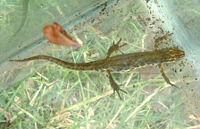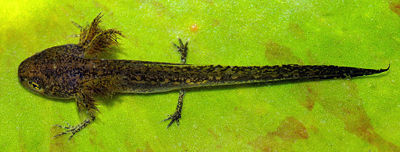Difference between revisions of "Newt" - New World Encyclopedia
Rick Swarts (talk | contribs) (added article from Wikipedia and credit/category tags) |
Rick Swarts (talk | contribs) |
||
| Line 1: | Line 1: | ||
| + | {{Claimed}} | ||
{{Taxobox | {{Taxobox | ||
| color = pink | | color = pink | ||
Revision as of 14:35, 31 March 2007
| Newts | ||||||||||
|---|---|---|---|---|---|---|---|---|---|---|
 Smooth Newt (Triturus vulgaris)
| ||||||||||
| Scientific classification | ||||||||||
|
Newts are small, usually bright-colored semiaquatic salamanders of North America, Europe and Asia, distinguished from other salamanders by the lack of rib or costal grooves along the sides of the body.
Characteristics
Newts have the ability to regenerate limbs, eyes, spinal cords, hearts, intestines, and upper and lower jaws. The cells at the site of the injury have the ability to de-differentiate, reproduce rapidly, and differentiate again to create a new limb or organ. One theory is that the de-differentiated cells are related to tumour cells since chemicals which produce tumours in other animals will produce additional limbs in newts.[1] Many newts produce toxins in their skin secretions as a defense mechanism against predators. Taricha newts of western North America are particularly toxic; the Rough-skinned Newt (Taricha granulosa) of the Pacific Northwest produces more than enough tetrodotoxin to kill an adult human foolish enough to swallow a newt. In order to cause harm, the toxins have to enter the body by being ingested or entering a break in the skin.
Handling newts
Theoretically it is safe to handle newts provided one thoroughly washes one's hands as newts secrete a toxin that is harmful if swallowed or if it comes into contact with mucous membranes. Newts also have the ability to carry the salmonella bacteria, although it's not likely, which causes food poisoning-like symptoms for several days.[citation needed]
Development
Newts can take several years to reach sexual maturity. Their main breeding season is between February and June. They hatch as tadpoles from eggs laid in ponds or slow-moving streams. In the case of triturus even brackish water is used, but most species are more picky. (see image on the right) Then they undergo metamorphosis, during which they commonly leave the water, only to return to the water to live out their adult lives. During the time right after metamorphosis, many North American Newt species go through a phase called the eft phase. In some cases their skin changes color, but efts always live their life on land, almost never seen in the water. Only when the eft reaches adulthood will it begin to live its life in a more aquatic fashion, and may rarely venture onto land. Many newts will live out their adulthood on land and only visit water to breed.
Distribution
The three common European genera are the crested newts (Triturus sp.), the European newts (Tylotriton sp.), the banded newts (Ommatotriton sp.), and some individuals such as the Spanish Ribbed Newt (Plurodeles waltl), the largest newt, and the Alpine newt (Mesotriton alpestris).
In North America, there are the Eastern newts (Notophthalmus sp.), of which the red-spotted newt (Notophthalmus viridescens) is the most abundant species, but it is limited to the area east of the Rocky Mountains. The three species of coastal, or Western newts are the red-bellied newt, the California Newt, and the rough-skinned newt, all of which belong to the genus Taricha, which is confined to the area west of the Rockies.
In Southeast Asia and Japan, species commonly encountered in the pet trade include the firebelly newts (Cynops sp.), the paddletail newts (Pachytriton sp.), the crocodile newts (Tylototriton sp.), and the warty newts (Paramesotriton sp.). In the Middle East there are the Middle Eastern newts (Neurergus sp.).[2]
Etymology
The oldest form of the name is eft, which is still used for newly metamorphosed juveniles, but according to the Oxford English Dictionary it changed for unknown reasons first to euft and then to ewt. For some time it remained as an ewt, but the "n" from the indefinite article (an) shifted to form a newt. See A, an for other examples.
Newts in popular culture
- The P.G. Wodehouse character Gussie Fink-Nottle, a friend of Bertie Wooster, has a fascination with newts.
- In 1936, Czech science-fiction writer Karel Čapek wrote an internationally-acclaimed novel called War With the Newts about the discovery of a species of intelligent newts in an island close to Indonesia.
- In Monty Python and the Holy Grail a peasant claims that a suspected witch turned him into a newt. He got better.
- The witches in Macbeth include "Eye of newt, and toe of frog, Wool of bat, and tongue of dog" along with many other repulsive ingredients in a recipe for their potion, but the "eye of newt" stands foremost in the popular imagination as the archetypical arcane spell ingredient.
- In the film Aliens the character played by Carrie Henn is nicknamed Newt.
- In the anime film Spirited Away (Sen to Chihiro no kamikakushi), grilled newt is a highly sought-after delicacy in the Aburaya bath house.
- In The Animals of Farthing Wood, the Newt family are among the animals who undertake the dangerous journey to White Deer Park.
- In the Nickelodeon cartoon Catscratch, the character Waffle owns many pet newts.
- In the Harry Potter series by J.K. Rowling the students take N.E.W.T.'s which are the exams for the 7th years at Hogwarts. McGonagall also offers Harry "ginger newts" in book five.
- The 6.10 version of the Linux distribution Ubuntu is codenamed "Edgy Eft".
- In the novel Matilda by Roald Dahl, Lavender, Matilda's good friend, uses a newt to play a prank on the head teacher Miss Trunchbull.
Notes
External references
Credits
New World Encyclopedia writers and editors rewrote and completed the Wikipedia article in accordance with New World Encyclopedia standards. This article abides by terms of the Creative Commons CC-by-sa 3.0 License (CC-by-sa), which may be used and disseminated with proper attribution. Credit is due under the terms of this license that can reference both the New World Encyclopedia contributors and the selfless volunteer contributors of the Wikimedia Foundation. To cite this article click here for a list of acceptable citing formats.The history of earlier contributions by wikipedians is accessible to researchers here:
The history of this article since it was imported to New World Encyclopedia:
Note: Some restrictions may apply to use of individual images which are separately licensed.
